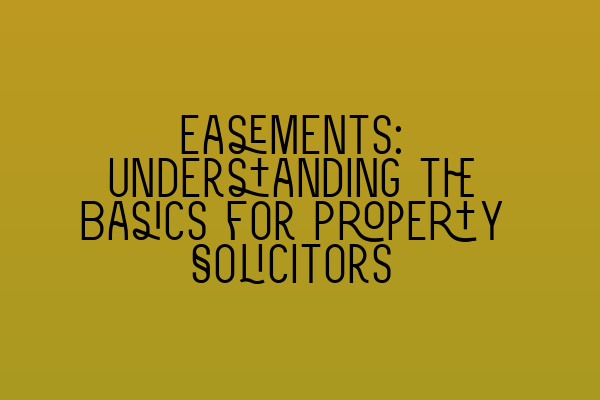Easements: Understanding the Basics for Property Solicitors
As property solicitors, it is important to have a comprehensive understanding of easements. Easements are a crucial aspect of property law, and having a clear knowledge of their basics is essential for providing effective legal advice to clients.
What are Easements?
Easements are legal rights that allow individuals to use or access someone else’s property for a specific purpose. These rights are attached to the land itself, rather than the individual who benefits from the easement. Easements can be created in various ways, including by express grant, implied grant, or by prescription.
Understanding the different types of easements is vital for property solicitors:
1. Right of Way:
A right of way is one of the most common types of easements. It grants an individual the right to travel through someone else’s property to access their own land. This could include a pathway, driveway, or road. It is critical to carefully review the terms and conditions of the right of way to ensure that it is properly granted and does not cause any undue burden on the servient property.
For more information on how to discern the validity of a right of way, check out our related article: SQE 1 Practice Exam Questions.
2. Right to Light:
A right to light easement grants an individual the right to receive a certain amount of natural light through windows or openings on their property. This easement is important when considering new proposed developments that may obstruct existing sources of natural light. It is crucial to assess the impact such developments may have on the rights of surrounding properties.
If you need assistance in understanding how to protect your client’s right to light, read our article: SQE 1 Practice Mocks FLK1 FLK2.
3. Right to Drain:
A right to drain easement allows an individual to discharge water or waste onto someone else’s property. This is particularly relevant for properties that share drainage systems or when one property is dependent on another for drainage purposes. Understanding the rights and responsibilities associated with drainage easements is crucial to avoid any potential disputes.
To learn more about the importance of understanding drainage easements, explore our related article: SQE 2 Preparation Courses.
Drafting and Enforcing Easements
As a property solicitor, it is essential to be proficient in drafting easements to ensure that they are clear, enforceable, and in compliance with the law. When drafting an easement, it is important to consider the following:
1. Proper Terminology:
The language used in easement documents should be precise and unambiguous, ensuring that the intentions of both parties are clearly expressed. Using appropriate terminology is key to avoiding future disputes.
2. Extent of the Easement:
The easement must clearly state the extent of the rights granted, including any limitations or restrictions. This will help avoid confusion or potential conflicts in the future.
3. Rights and Obligations:
The document should clearly outline the rights and obligations of both the parties involved. This includes specifying who is responsible for maintenance, repairs, and any associated costs.
To ensure that your drafted easements are legally sound and enforceable, it is always a good idea to seek the assistance of an experienced property solicitor.
For comprehensive preparation in property law, check out our related article: SQE 1 Preparation Courses.
The Importance of Expertise in Easements
As a property solicitor, having in-depth knowledge of easement laws and regulations is crucial for providing the best possible legal advice to clients. Understanding the basics of easements enables you to effectively identify potential issues and offer strategic solutions.
It is also worth noting that the SQE exams are a requirement for admission as a solicitor in England and Wales, and having a comprehensive understanding of property law and easements is essential. To stay updated on important exam dates and other relevant information, be sure to visit: SRA SQE Exam Dates.
In conclusion, easements play a significant role in property law, and as a property solicitor, it is vital to comprehend their basics. Understanding the different types of easements and having expertise in drafting and enforcing them can greatly assist in providing effective legal advice to clients. Stay up to date with the latest developments in property law and easements and ensure that you have the necessary expertise to serve your clients’ needs.
